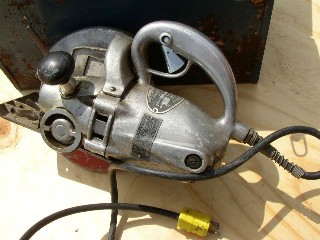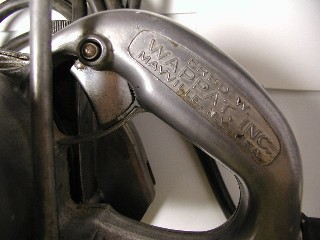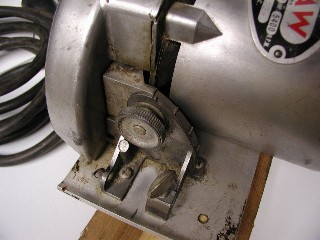The Wappat Web Site is pleased
to produce this page on behalf of our American branch of the family, who
have been very helpful at providing photos and information for the site.
We would like to thank in particular
Brad, his daughter
Carri, his brother
Bob and his brother and sister-in-law
Dick and Terri. |
|||||||||||||||||
|
|
|||||||||||||||||
Wappat Drill by Fred W
Wappat |
|||||||||||||||||
|
|
||||||||||||||||
|
|||||||||||||||||
|
|
|||||||||||||||||
Cummins Maxaw Saw - Engineered by Fred
W
Wappat |
|||||||||||||||||
|
I need to gain permission before photos of this Saw can be displayed. |
||||||||||||||||
|
|||||||||||||||||
The Fred W Wappat Saw
Company - Manuals and Lubricant
Can |
|||||||||||||||||
|
|||||||||||||||||
|
|
|||||||||||||||||
The Fred W Wappat Saw
Company - A-8" Photographs, August
2003 |
|||||||||||||||||
|
|||||||||||||||||
|
|
|||||||||||||||||
The Fred W Wappat Saw Company - Maxaw 6" Photographs, August 2003 |
|||||||||||||||||
Many thanks to Frank Marquart of
Westbury, New York, for the following excellent photographs of the 6" Maxaw
Saw. |
|||||||||||||||||
|
|||||||||||||||||
|
|
|||||||||||||||||
US Invention Patents for Fred W Wappat, July 2003 |
|||||||||||||||||
These drawings come from the Directory of American Tool and Machinery Parts
(DATAMP) |
|||||||||||||||||
Innovations to the above hand saws are the improved retractable guard, a cutout in the guard so the operator can see the cut line, and a means of clearing sawdust from the cut line. Notice the worm drive (Fig 2, part 10) referred to in the article by David Pitkin below; it efficiently provides great torque for cutting large timbers and stone. Much more detail is available in the patent copies from USPTO. If you search for 'Wappat' on the USPTO site, you will obtain a list of 47 patents, right up to present day, that list one of Fred's inventions within their own. It seems his designs are robust enough to be incorporated in power tools today! Posted by Andrew Wappat |
|||||||||||||||||
|
|||||||||||||||||
Blanche King Smith Wappat - Research, July 2003 |
|||||||||||||||||
| I originally found a reference to a 'Blanche King Smith Wappat'
back in 2000, when searching our name on the Internet. The web page was fairly
vague, just mentioning that Blanche was listed in "Who Was Who Among North
American Authors, 1921-1939, Volume 2, K-Z" and in "Who's Who in American
History Volume I, 1897-1942"
It was some time later that I found a reference to 'Blanche Wappat' in a document from the Pittsburg Chapter of the Special Libraries Association (SLA) listing her as their second President from 1923-1926. I emailed the librarian via the current SLA website and was lucky enough to be contacted 5 months later by the archivist for the Pittsburg Chapter, Sheila Rosenthal, Librarian at the Software Institute Library, Carnegie Mellon University. Sheila kindly searched the archives, including minutes of meetings and official chapter business correspondance, and finds her listed as Mrs Blanche K S Wappat, but on the official printed letterheads, with the SLA logo, Blanche is listed as Mrs F W Wappat, Carnegie Institute of Technology. Those initials immediately made me think of Fred W Wappat, born in Pittsburg, and also know for his technological inventions!
Sheila was also prepared to visit the Carnegie Public Library, and found
the entry I had been waiting for, in "Who Was Who Among North American Authors"
.It confirms that Blanche was the wife of Fred W Wappat, and thus officially
a connected New York Wappat. I have edited the entry to remove abbreviations,
and the adpated version is below: WAPPAT, BLANCHE KING SMITH: librarian Born Pittsburgh, Pa., September 1889, the daugther of James Alexander Smith & Sue Luella Smith (nee Thompson) Blanche was educated at Pittsburgh and Baltimore public schools, followed by private instruction at the Carnegie Library School, where she obtained a diploma. She married Fred William Wappat. She wrote articles for the American Library Association Proceedings in 1926, and Special Libraries. She was librarian at the School of Applied Design and College of Fine Arts, Pittsburgh, from 1913-1919; librarian of the Carnegie Institute of Technology, from 1920-1929; and special lecturer at Carnegie Library School from 1930-1931. She was a member of the American Library Association, the Special Libraries Association and the Library Club. Her religion is listed as Episcopalian, and her home as Cleeve Hill Cottage, Macon Avenue, Pittsburgh, Pa. Being the second President of the Pittsburg Chapter of the recently formed Special Libraries Association, it appears to she had some influence in the access to information during the era of scientific and industrial developments. For more information on the history behind the formation of the Special Libraries Association, visit the Historical Highlights page of the SLA. For more information about the role of the president, visit the President page of the SLA. At the moment, I am awaiting the entry for Blanche in the "Who's Who in American History" volume to see if there are more records of her life. We are currently unsure how long she lived for. Posted by Andrew Many thanks to Sheila Rosenthal of Carnegie Mellon University for much of the research above, and to Barbara Folb of Pittsburg University for passing on my original email. |
|||||||||||||||||
The Fred W Wappat Saw Company - 2A Photographs, July 2003
The Fred W Wappat Saw Company - A-9"
Photographs, April 2002
|
|||||||||||||||||
|
|
|||||||||||||||||
Correspondance on the History of the Fred W Wappat 9" Saw, February 2002 |
|||||||||||||||||
I was thinking about what has been said regarding Fred Wappat saws being used to build the Washington Monument, and realized the unusual serial # (1 of 164) would be consistent with a limited production for a specific project. If that's the case, I would also assume that all 164 saws had the same serial number. It seems, though, that the saws must have been built for a federal project different from the Washington Monument. The monument was "built at intervals between 1848 and 1885" according to information I've seen on the web http://ns.kreative.net/cooper/TourOfDC/monuments/washington-monument/. Since Fred wasn't completed until 1886, the Washington Monument predates him.
The Lincoln Memorial was built at invervals between 1915 and 1922
http://library.thinkquest.org/17188/lincoln.html?tqskip1=1&tqtime=0222. Construction of the Jefferson memorial seems to fall into the right time period. According to this website, http://library.thinkquest.org/17188/jefferson.html?tqskip1=1&tqtime=0222 "The final memorial design was chosen in 1938 and groundbreaking took place on December 15 1938. President Roosevelt turned the first shovel of dirt. The structure's cornerstone was laid on November 15 1939. The memorial was opened to the public with a dedication by President Roosevelt in 1943. It was the anniversary of Jefferson’s birth." There are lots of memorials in D.C., so of course there are lots of possibilities. Further down this site http://ns.kreative.net/cooper/TourOfDC/monuments/washington-monument/ it states that "The top may be reached by elevator or by an iron stairway. The first elevator was a steam hoist, used until 1901 when the first electric elevator was installed. The present elevator, installed in 1959, makes the ascent in 70 seconds. The iron stairway consists of 50 landings and 897 steps." Looking more closely at the saw I have, it could have easily been produced in the late 1950's -- maybe the Fred Wappat Saw Co. was contracted to produce saws for the installation of the new elevator in 1959, which would have been a tremendous job, considering the monument is over 500 feet tall. The primary construction of the three memorials I mentioned earlier is marble and/or granite. An elevator project would probably require the construction of a tremendous wooden framework of large timbers, which the saw I have was definitely designed to cut. Who knows? The worm drives are great for handling large timbers, but they are also ideal for cutting stone, provided the correct masonry blade is used. The worm gear design produces tremendous torque with little effort; hence, they never seem to wear out. The saw I have is 40+ years old and probably remains as strong as the day it was built. This is all very interesting to me. The saw could have been used for stone or timber. The Stanley tool company made a 9" worm drive in the 1950's, now highly prized by timber framers, which used a 9 amp motor. The 9" Wappat saw has an 11 amp motor. I have an old catalog that lists the Stanley worm drive saws, and I seem to recall that the 9" model sold for around $190, a staggering sum in the 1950's. I'm wondering if the U.S. government projects required saws that were beefier than the Stanley saws. If the Wappat saws were procured for the 1959 elevator installation, there may have been a bunch of marble cutting work that went along with the project, especially if they had to enlarge an area to accept the new elevator shaft. Many thanks for the research, courtesy of David Pitkin. |
|||||||||||||||||
|
|
|||||||||||||||||
Family Photographs of Richard and Terri Wappat
and children, November 2000. |
|||||||||||||||||
|
|
||||||||||||||||
|
|
|||||||||||||||||
Graduation of Carri Wappat from college in
Boston, on the 12th May 2000. |
|||||||||||||||||
|
|
||||||||||||||||
Carri Leigh and father Bradley David Wappat |
Carri and brother Timothy David |
||||||||||||||||
|
|
||||||||||||||||
Carri and brother Thomas Ryan |
Thom and aunt Carolynn Kaye |
||||||||||||||||
|
|
||||||||||||||||
Tim and mother Mindi |
Carri and Nate |
||||||||||||||||
|
|
|||||||||||||||||
Some History about the New York State Wappats. |
|||||||||||||||||
The New York State Wappats' closest relatives are the
Teesside and Tyneside Wappats from North-East England. All three branches
are descended from the children of William Wappat (1793) a husbandman from
Whorlton, Durham. William's second child Robert Wappat (1815) was a iron
works labourer and coal miner. He had one son William Wappat (1847) who was
originally a boot maker. He emigrated to Pennsylvania, USA in 1880. |
|||||||||||||||||
It is hoped to add more details soon. |
|||||||||||||||||
| Return to top of page
|
|||||||||||||||||



























